The offspring of George March and Elizabeth Pike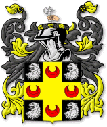
WILLIAM MARCH 1885 - 1948
William was named after his grandfather, being born at Craghead, Durham on Saturday 14 March 1885, the eldest child to a coal miner, George March and his wife, Elizabeth (Pike). The 1901 Census will show William working as a coal miner, and on Friday 10th April that year, the evening of the Census, he was living at 26 Railway Street in Craghead. His parents had lived in Craghead since around 1882, having previously both lived at Holmside Parish, in May 1893, William was recorded as living at 21 Thomas Street in Craghead, the birthplace of my grandfather,. Thomas March (1893 - 1963)
William married Elizabeth Bradshaw at Sunderland on Saturday 2nd October 1909. Elizabeth was born on Sunday 18th August 1889 at West Cornforth, Durham, the daughter of William Bradshaw and Elizabeth Daniel. The latter were married at Ormskirk in Lancashire, England on 28th October 1882. Census records suggest that William Bradshaw originated from Northwich, Cheshire around 1860, the illegitimate son of one Sarah Bradshaw, while his wife, Elizabeth apparently hailed from York. Although both died in Utah, America in 1941 and 1930 respective, their years in England seemed to consist of travelling on a regular basis. From 1882 until 1885, they were living in Pendlebury, Lancashire, but by 1889 were living in County Durham, at West Cornforth. By 1891, the Bradshaw's lived in Hebburn, near Jarrow before moving, once again to Lancashire. The 1901 Census states their abode as Pendlebury. Also in 1901, the family may have lived near Liverpool but this is uncertain at present. Between 1901 and 1909, the Bradshaw family once again moved north east, to Sunderland, where they lived in 1909, and moved to; Shiney Row near Houghton-le-spring around 1910. The 3911 Census shows their abode in Shiney Row. I believe the Bradshaw's journey to Utah occurred before 1921.
Following their wedding in 1909, William March and Elizabeth Bradshaw made their home at Grangetown, Sunderland, before moving to 3 Back Buttsfield Terrace, Old Penshaw Village by 2nd April 1911. In the early quarter of the 20th Century, William and Beth both attended a Latter Day Saint (LDS) church in Sunderland. It is known that they emigrated to Utah, Salt Lake City in 1920, and continued with the Mormon faith. One given reason for William's departure from England lies direct with his faith and belief in the LDS Church, It is said that his family disowned him when he joined the LDS, and so, to save himself and his family from ridicule. William and Elizabeth went to Utah, the heart of the LDS Church. Here, they would feel safe from ridicule and harassment. In July 1920, William, Elizabeth and their two children, Marion and Lawrence March left County Durham for the last time and made for Liverpool. Here, on Tuesday 20th July 1920, they boarded the turbine steamer SS Victorian, bound for Sydney, Nova Scotia in Canada. The ship arrived in Canada on Thursday 29th July 1920, and from there, the March family made their way west, to Utah. One area that the March family are known to have passed through, en route to Utah, was St. Albans in Vermont
Their journey across the Atlantic was probably an average event with nothing out of the ordinary. From the records of the SS Victorian it is known that William and his family would have listened to musical records on the ship's transmitters. Back in the 1920s and 30s, it was the custom of the time for ships passing one another in Mid-Atlantic to; salute each other by playing musical records over their communication radio transmitters. The SS Victorian was one of seven named ships to have broadcast radio programmes. When the ship left England in 1920, it's passenger included delegates who were due to attend the Imperial Press Conference in Ottawa, Canada. Each day of its 9 day voyage, a program of speech and music was transmitted on the long wave channel 107 kHz to the Victorian from MZX at Chelmsford, England and also from MPD at Poldhu in Cornwall. Each evening was just as entertaining for the time. While en-route across the Atlantic, the Victorian broadcast brief concerts to passing ships from its own 3kw transmitter MVN. Also, the Canadian Marconi Company broadcasted voice messages to the SS Victorian throughout its Transatlantic voyage.
The SS Victorian was built in 1904 at Belfast. This 520 feet long x 60.4 feet wide ship was launched on 25th August 1904 as the first turbine steamer on the North Atlantic. It's estimated speed is given at 18 knots. The maiden voyage; on 23rd March 1905 was from Liverpool to St. John's, Newfoundland. In 1917, the Canadian Pacific Line took over the control of SS Victorian, and in 1922, renamed it SS Marloch. On 2nd February 1926, this ship was in a collision with SS Whimbrel and was towed to Southampton. It was eventually scrapped at Pembroke Dock in 1929.
In 1924, the March family moved to Castlegate, Carbon County, Utah where William worked as a coal miner.
They lived in Price, Helper, Utah from December 1929. Price and Helper are two adjoining towns in Central Utah. Helper lies 7 miles North West of Price, and 120 miles south east of Salt Lake City. From Helper, I believe William and Beth probably moved to Huntington City which 1 think lies south west of Helper. They then moved North West to Salt Lake, before moving to Murray City. It was in Murray City, Utah that he died on Thursday 1st July 1948. William had terminal cancer, and was buried at 3pm on Tuesday 6th July 1948 in Murray City Cemetery, his grave location being 08/ 035/ 8.
According to William's obituary notice, dated July 3rd 1948, he died at 8.15pm at his residence, that being
5615 South 6th West, Murray. The notice also suggests that he died from a heart ailment, although relatives stated the cause of death was actually cancer. William's death certificate states that he had been diagnosed with stomach cancer since around March 1948, and was tended to by a doctor from June 1st 1948 until his death a month later. When William moved to Murray City, he worked as a stockman for the Madsen Wholesale Co. He was also a high priest in the Murray Second Ward, Church of LDS, and at the time of his death, was an active Sunday school teacher. Confirmation from William's nephew, Ted Bradshaw tells how William stopped working due to a bad heart, and that the obituary column probably made the death sound more acceptable by stating heart failure, rather than cancer of the stomach. William's social security number was 528-09-4766. William's death certificate also states that he was a veteran of World War One, but so far, no records have been found.
History of Carbon County suggests that from the 1870s until the 1920s there was a peak of Italian immigrant’s in Carbon County. This eventually led to a strike, in 1922. Anti-social attitudes led to the formation of the Ku Klux Klan in Utah, with Klan activity reaching its peak in 1924 and 1925. Records show that certain demonstrations were held in the vicinity of the Mormon church, although it is a fact that the LDS teachings do not encourage such acts of racial violence, and so, in reality, any Klan activity can not be associated with the Mormon faith;
William and Elizabeth had two children, unfortunately both are now deceased. Lawrence Bradshaw March was born at Old Penshaw, near Sunderland on Friday 27th August 1915, and was baptised there on 26th September 1915. He died from heart disease in Salt Lake City on Tuesday 4th October 1966, and was buried in Murray City Cemetery, also known as South Cottonwood Cemetery, so named because of its closeness to the city of Cottonwood. Lawrence wed Betty Bernice Kimball at Salt Lake City on Friday 30th June 1944 and had two sons named
George Kimball March and Myron Kimball March. Lawrence's social security number was 528-07-7046. In later years Lawrence lived in Helper before moving to Price and then onto Murray City. He attended Murray High School and then LDS Business College. Later, he attended Brigham Young University and then the University of Utah extension classes and went on a mission for the LDS Church in Texas, later becoming a school maths teacher. Incidentally, regarding that of Klan activity, it is said that Lawrence, to his disgust, did actually see a black individual hanged. In the enclosed documents, following these pages, Lawrence gives his own account of his early life from 1915 until 1929. This is in his own hand writing.
Marion March was born at Grangetown, Sunderland on Saturday 4th December 1909, the only daughter to William and Elizabeth. She died on Sunday 24th December 1995. She married Walter Vincent Coppinger in San Francisco on Sunday 13th October 1946. They had no children. Marion lived out her days in California. Walter is believed to have died on 13th August 1980 in San Francisco, possibly being born there on 3rd January 1920. He was possibly the son of Michael Coppinger and Mary Shanahan, Walter's social security number, given on the US death index was
717-14-0695.
George March, the eldest son of Lawrence and Betty, was born at Salt Lake City on Monday 24th December 1945 and married Catherine B. Hughes in Las Vegas on Saturday 6th April 1968. They have three children, all born in Utah. They are named Tiffany March (born 11.3.1970), Tyler Kimball March (born 18.7.1977) and Thomas Fenton March (born 22.8.1979).
Lawrence's youngest son, Myron Kimball March was born in Salt Lake City on Tuesday 16th November 1948, being baptised in February 1949. He wed Fara Ruth Nygren in Salt Lake City on Tuesday 5th August 1969, and had three children. They later separated, and Myron married Cindy Williamson on Wednesday 29th December 1999. The eldest child, Jennifer March was born at Murray, Salt Lake on 4th February 1971, but died the same day. She is buried in Murray City Cemetery. In a recent correspondence with Myron, he informed me that he also has two step-daughters from his second marriage.
Heather March was born at Salt Lake on Friday 10th March 1972, being baptised in Utah on 2nd April 1972.
Their third child, Melissa March was born at Salt Lake on Monday 19th February 1973 and was baptised in Utah on Sunday 6th May 1973.
I am currently in correspondence with Melissa. She has four children to her husband, Cody Gordon. The eldest, Denisha Gordon, was born at Gunnison, Sanpete, Utah on Friday 3rd November 1995, and was baptised in Ephraim. Sanpete on 3rd December 1995. Daughter number two is Savannah Gordon, born Sunday 5th October 1997at Gunnison, Utah. She was baptised at Ephraim on 2nd November 1997. The third daughter is named Jenny Gordon, born in Gunnison on Monday 29th November 1999. Jenny was baptised at Ephraim on 6th February 2000. The fourth child to Melissa and Cody is named Jessica M. Gordon, born in Cedar City, Utah on Saturday 28th June 2003. She was baptised in Enoch, Utah on 3rd August 2003.
My father, James March kept in touch with his Aunt 'Beth’, by means of letter, but lost touch during the early 1960s. Through internet access, it is known that Elizabeth died at Farmington, Davis, Utah on Friday 5th May 1978. The Mormon Index (IG.I.) gives her social security number as 529-09-5612. Elizabeth was buried on 6th May 1978 in the same cemetery as her husband. Her grave location is 08/ 035/ 7. Both William and Elizabeth have different grave reference numbers, but this may be a confusing issue as both are buried in the same double grave. I was originally in touch with the niece and nephew of William and Beth. They are named Verda Morford and Theodore (Ted) Bradshaw. Ted had submitted important information which had eventually put me in touch with Melissa March Gordon. The latter currently lives in Blackfoot, Idaho. Both Ted and Verda, in their letters to me, refer to William as Uncle Bill.
English BMD and Census records for the Bradshaw family, suggest that, in 1911, in Shiney Row, only six of a possible eleven children, born to William Bradshaw and Elizabeth Daniel actually lived to, and beyond that year. Elizabeth Bradshaw (1889) had wed William March in 1909 and is therefore excluded from the Bradshaw household in 1911.
The six children listed were as follows:
John Henry Bradshaw - born on 5th November 1883 in Pendlebury, Lancashire. Died in November 1962 in Utah, America.
Sarah Ellen Bradshaw - born in 1885 in Pendlebury. Lancashire. Died in America in 1947.
David Bradshaw - born on 3rd October 1891 at Hebburn, Durham. Died in Idaho, America in May 1964.
Charles Bradshaw - born on 9th June 1901 in Liverpool. Died in September 1972 in Arizona, America.
Nevan Bradshaw - born around 1906 in County Durham.
Violet Bradshaw - born in 1909 at Sunderland,
Ted Bradshaw, in an earlier correspondence stated there were four further offspring, these being as follows:
Lilly Bradshaw - born around 1894, dying the same year.
Florence Bradshaw - born around 1896, dying in 1897.
William Bradshaw - born around 1898, dying the same year.
Charles Bradshaw - born around 1893.
Another child, Betsy Bradshaw was apparently born around 1887, but died around 1888. No records may be yet found for the latter Charles, and also. Ted informed me that Nevan was born around 1895, which contradicts the 1911 Census.
THOMAS MARCH 1893 -1963
Craghead came into being when its first colliery, The William Pit was sunk during 1839 and like the other mining villages in the area, really only developed with the introduction of the local collieries. The first colliery houses to be built in the village were those at Wagtail terrace, followed afterwards by the other streets such as William Street, Edward Street, and Thomas Street. The latter was the birthplace of my grandfather, Thomas March on 31st May 1893. The house that he was born in, number 21, no longer exists, but Thomas Street still survives, set behind the main street of Craghead. Number 21 Thomas Street is now replaced by bungalows, but back in the 1890s, all these 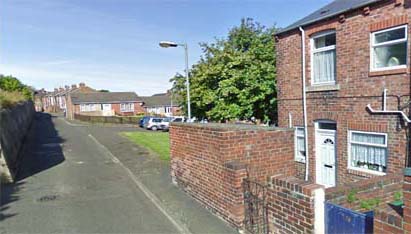 houses in the village shared the same design. The downstairs room would be paved with red flagstones, and a large fireplace with a set-pot for hot water on one side and a round oven on the other. In between these rows of houses were the ash-pits and closets. The earlier streets had no ceilings and the upstairs room was reached via a ladder. Each room had one window and only one door
houses in the village shared the same design. The downstairs room would be paved with red flagstones, and a large fireplace with a set-pot for hot water on one side and a round oven on the other. In between these rows of houses were the ash-pits and closets. The earlier streets had no ceilings and the upstairs room was reached via a ladder. Each room had one window and only one door
Right – modern day Thomas Street at Craghead in 1893, number 21 Thomas Street was extended past the house in the foreground.
In the late 19 Century, Craghead was built around a busy main street of which some of the shops survive although; the majority have had a face-lift over the years. In 1900, the main street consisted, in order, of the following businesses: - General Dealer (T. Armstrong), Draper (J. Richardson), Post Office (W. March), Newsagent (J. Burton), Cobbler (W. Wilson,)
Hotel (S. Leighton), Hairdressing and billiards (C. Buckton), General Dealer (G. Race) and Butcher (Mr. Oswald).
William March, the sub post-master was the uncle of Thomas March, and the latter later gained employment under William Wilson, the local cobbler. Mr. Wilson was also related to Thomas, on his mother's side of the family. In general, Craghead was a very close knit community.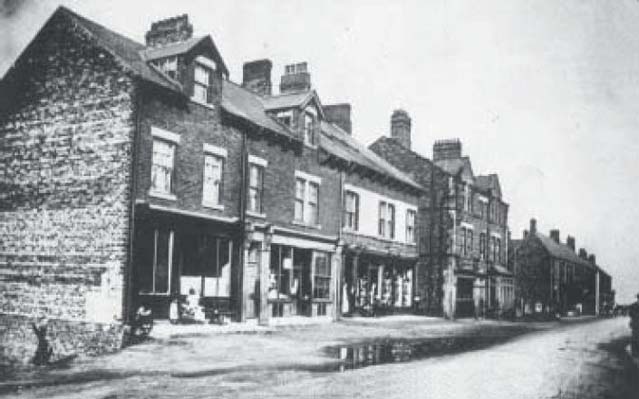
Right – Craghead Front Street in 1900.
My grandfather remained at 21 Thomas Street until he was about 3 years of age, before his family moved to 26 Railway Street on the brow of the hill overlooking the open fields that was to become St. Thomas' Church, and it was here, at Railway Street, on 13th April 1905 that his mother, Elizabeth, passed away aged just 43, leaving her husband, George, and seven children behind. The youngest of these offspring, Hilda March was just two years old at this time.
Thomas began working as an apprentice shoe-repairer around 1907, most likely under the guidance of William Wilson at this time, in Craghead. He continued in this trade until the First World War in 1914, upon which he was enlisted into the Northumberland Fusiliers and following the War, Thomas continued in the shoe repair trade. However, the mid 1920s saw him working as a colliery shifter in Stanley.
When Thomas courted my grandmother, Mary Ellen Laidlow, it was not a quick affair. Their parents had been friends since at least 1882, when Mary Ellen's mother had been the bridesmaid at the wedding of George and Elizabeth March. Thomas an Mary Ellen married at Lanchester Register Office on 27th September 1913, and at this point, both parties lived in South Moor, residing at 24 Maple Street. This was a common occurrence between couples who were to wed, as it often saved on the cost of the wedding if the would-be bride and groom co-inhabited the same house prior to the event. My grandmother, herself originated from South Moor, having been born at 7 Poplar Street on
17th January 1894, and following their wedding, my grandparents settled for a while at Maple Street.
Mary Ellen Laidlow was the daughter of William Laidlow and Mary Ann Robson, the latter marrying at Stanley in 1893. Her father had abandoned his family between 1896 and 1900, and, when her mother died in 1907, Mary Ellen was cared for by her aunt Henrietta and her half-sister, Margaret Robson. They all lived under one roof at 7 Poplar Street with the head of the household being Mary Ellen's grandfather, Robert Robson. Activity involving my grandmother's family had taken place at this address since the 1880s. Mary Ellen often thought she had two birthdays and the reason for this is clear; since the start of civil registration in 1837, births could be registered within six weeks at no charge, thereafter it would cost seven shillings and sixpence in old money - a powerful incentive for informants to state that a birth had occurred later than it did. This is why some people believe they have two birthdays - a 'true' one, and an 'official' one. Mary Ellen Laidlow was baptized at the Wesleyan Methodist Church in Shotley Bridge on
7th October 1894. She was one of three children born to William and Mary Ann.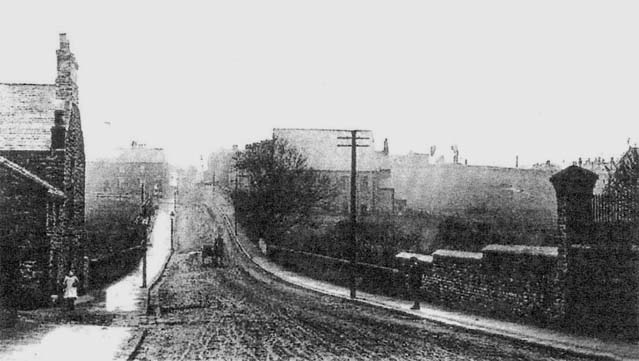
Right – How South Moor looked in 1914, South Moor Colliery is in the background.
Two sons were born to Thomas and Mary Ellen, in South Moor, but alas, only one survived, that being Thomas March Junior, born on 23rd November 1915. The eldest son, George March had been born in 1914, but sadly, died a short while afterwards.
In 1917, Thomas and his family lived
at 39 Mary Street in Stanley, and remained here until the late 1920s. Until 1832, Stanley was only a small hamlet consisting of Stanley Hall and a few nearby cottages. The following year, Mr. J. H. Burn sunk a pit near an old farm house named 'West Stanley' and named this pit 'West Stanley Colliery'. Colliery houses were later built in the east of Stanley by Mr. James Joicey, who named the area 'East Stanley'. Joicey was a very influential and respected person and his tomb stands in
St. Margaret's graveyard at Tanfield, he having died in 1863.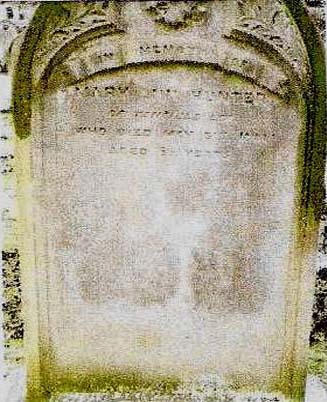
The important factor here though, lies not only with James, but with his younger brother John Joicey. From the late 1840s until the 1860s, Mary Ellen's great-aunt, Mary Ann Hunter, was the Housekeeper for John Joicey, with the latter's son, William James Joicey possibly suspected as being the son of John and Mary Ann. What stoked more suspicion was the fact that, when Mary Ann Hunter died in 1881, all her money went to William, a sum total then of 989 pounds, 13 shillings and 1 penny. However, the marriage certificate of William does name James Joicey as his father.
Right – The grave of Mary Ann Hunter at Tanfield.
Mary Street currently consists of about ten houses from the original set. It begins from number 53 and finishes at number 44. The house where my grandparents lived in 1917, stood approximately near where the turn-off to Cheers off-license is situated today.
It is known for certain that Thomas and Mary Ellen had lived at 39 Mary Street during the war years, due to the recollections of Thomas March Junior. The latter had told me how Mary Ellen's great-uncle, George Robson, would walk the distance from 7 Poplar Street in South Moor, to 39 Mary Street in Stanley, regularly on a Sunday for his lunch, prior to his death in October 1917. Mary Street was also the birthplace of my father, James March, on
30th November 1918, as well as Thomas and Mary Ellen's youngest son, Henry March, on 24th May 1926.
Around 1929, my grandparents left Stanley and moved into 19 Clayton Ville, part of the new village built to the south of Blackhouse. The village had been constructed in 1925 and consisted of 164 houses. Clayton Ville was named after an early 20th Century Headmaster of Edmondsley School. However, the whole village was demolished by 1978, due to persistent dampness problems, and the residents were re-housed in new homes in Edmondsley's Jubilee Close. When my grandparents first came to Clayton Ville, they shared the premises with another family, named Duffy. The latter later moved to Doncaster, and the local council agreed on letting Thomas and Mary Ellen occupy the premises of 19 Clayton Ville. Four years after the Second World War, these premises were again co-inhabited. The electoral register of 1949 shows that Thomas Barras Finley and his wife, Minnie lived with my grandparents and in 1955, the Quinn family lived here when they arrived in County Durham from West Yorkshire. It was at 19 Clayton Ville that my parents first met.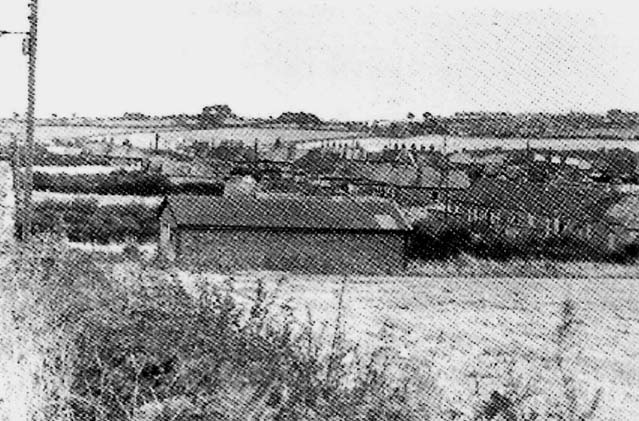
Right – Blackhouse Village, pictured in the 1960s. The March family lived in number 19 Clayton Ville, pictured to the right of the building in the fore-ground.
Thomas March kept a family bible, which he acquired around 1920, and he operated as a Layman Preacher until 1940, authorized to perform religious ceremonies except marriages. Most Sundays, my grandfather taught sermons at a chapel near St Thomas' church in Craghead. Following the early months of World War Two, his son, James, who was serving with the Durham light Infantry, was captured by German forces at Neuville in France and served as a Prisoner Of War until 1945. Apparently, because of this event, Thomas lost all faith in the teachings of the bible, causing him to never again believe in the holy book. Many years later, his bible became my property.
When my mother and her family moved to 19 Clayton Ville in 1955, Thomas was still working as a shoe-repairer, working in Sacriston at that time, and it was not unusual to see him repairing footwear in his house, but he had retired from full - time work around 1960, most likely to do with his health. He eventually contracted bronchitis, which was a main contribution to his death, along with heart failure.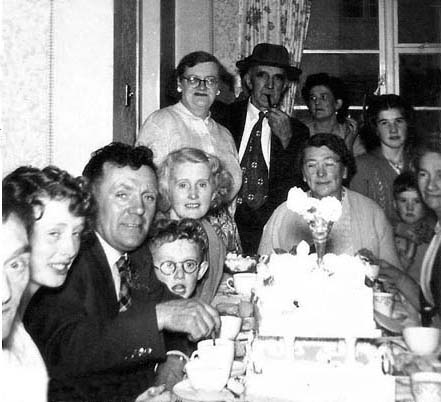
Right – October 1959 and possibly the last photograph to be taken of my grandfather.
He is pictured here, at the wedding reception of my parents.
Thomas is standing at the rear, wearing his hat5 and smoking a pipe
Around 1962, a story unfolded, regarding a family named O'Brien. This family had apparently been evicted from their home in nearby Burnhope and there-after, took to living in the woods at Blackhouse, where a child was born. Thomas and Mary Ellen invited the O'Brien's to live in a back room at 19 Clayton Ville. When my grandfather died, differences arose between my grand-mother and the O'Brien's, and this led to the former moving briefly to 17 Clayton Ville, the home of
'Old Ma Simpson'. My grandmother eventually moved into a bungalow at Jubilee Place Edmondsley, living there for about
3 weeks, until her son, Thomas travelled from his home in Ollerton, Newark and packed my grandmother's clothes into a single bag, and took her to live with him at Cedar Lane in 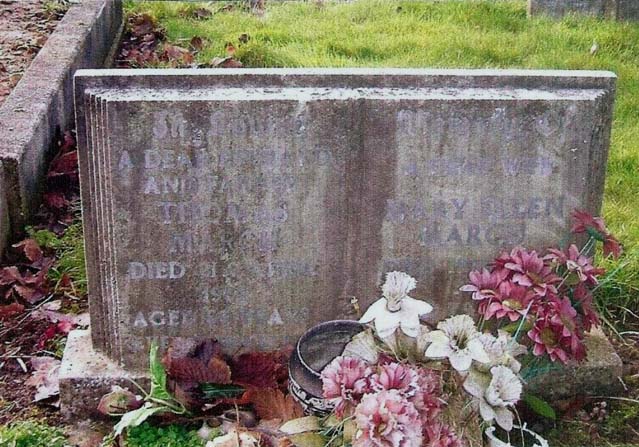 Ollerton. The 1960s marked the end of the March family association with Clayton Ville. My grandfather died at 19 Clayton Ville on Sunday 21st April 1963 at the age of 69, this occurring just four months prior to my birth. He had been ill for a while, prior to his death. Thomas was buried in a double-grave in Sacriston Cemetery, which ten years later, would, also become the final resting place of Mary Ellen.
Ollerton. The 1960s marked the end of the March family association with Clayton Ville. My grandfather died at 19 Clayton Ville on Sunday 21st April 1963 at the age of 69, this occurring just four months prior to my birth. He had been ill for a while, prior to his death. Thomas was buried in a double-grave in Sacriston Cemetery, which ten years later, would, also become the final resting place of Mary Ellen.
Right – The grave of Thomas and Mary Ellen March in Sacriston Cemetery
Offspring of Thomas March and Mary Ellen Laidlow
GEORGE MARCH - Was born at 24 Maple Street, South Moor in 1914, being named after his grandfather. Sadly, George died soon after his birth.
THOMAS MARCH - Was born at 24 Maple Street, South Moor on 23rd November 1915. He was baptized at St. George's parish church in South Moor on 9th December that year. Thomas lived with his parent's right up until they moved to Blackhouse Village around 1929. Leading up to World War Two, Thomas worked as a coal miner and is thought to have served with the T.A.division of the Durham Light Infantry, but was probably called back to civilian life before he saw any further service.
Thomas married Georgina Bradley at St. Thomas’ Church in Craghead on 1st May 1943. The latter was born at 6 Pasture Row, Eldon, Bishop Auckland on 22nd August 1908, one of 12 found children born to a coal miner named George Henry Bradley. From Georgina's marriage to Thomas March, three children were born, named Eileen (1945), James (1947) and Kathleen (1950). Georgina also had another daughter named Elizabeth Bradley, born out of wedlock in 1932 and dying in 2004. Georgina herself, died in 1982.
The latter was only 13 when her father died in 1921; he had been born in Thornley, Durham in 1856. The Bradley line had lived in Yarm since the mid to late 1700s, but when George Henry Bradley's parents wed in 1841, they eventually moved to Shildon, but by the late 1840s were living in Thornley.
George Henry Bradley was married once and had one common-law wife. In the district of Auckland, Durham in 1883, he wed Elizabeth Martha Moody, a native of Southampton. She lived from 1861 until 1890. Elizabeth's father had died in Southampton in 1872, and her family then moved to County Durham where her mother re-married in 1874 to a Welshman named John Jones. In the 1880s, they lived at 8 Garbutt Street in Shildon.
In 1943, Georgina Bradley was living at Clayton Ville in Blackhouse, but around 1964, she and Thomas moved to Ollerton in Newark, residing at Cedar Lane. Their daughter, Eileen had moved to that region a short time beforehand. Later, Thomas and Georgina moved to Petersmith Drive before eventually settling at 14 Sycamore Road in Ollerton.
Thomas later moved to 11 Amberside in Ollerton, this being the address I last saw him at in 1989. Sadly, he passed away at the Kingsmill Hospital, Sutton in Ashfield, Mansfield on 20th July 1990, and was buried in New Ollerton Cemetery.
HENRY MARCH - Was born at 39 Mary Street, Stanley on 24m May 1926. He married Doreen Foreman in County Durham on 29th September 1945, and from this union, there were four children, named James Thomas (born 23.4.1946), David (born 24.2.1948), George (born 6.4.1950), and Alice (born 11.4.1952).
Doreen Foreman was the daughter of Walter and Evaline Foreman, being born at Beamish in 1925. Her baptism took place at St. Paul's in Pelton on 25th May 1927. Ironically, Doreen, who was 2 years older than her brother Walter, was baptized a month later than the latter. In 1927, the Foreman family lived at 58 John Street in Beamish. Doreen died in Newark in 1995.
Henry, by all accounts, apparently joined the air force around 1951, and was once allegedly serving in Egypt at R.A.F. Station 'Deversoir' Canal Zone, Middle East Air Force 10. His service number was 2303198.1 am not aware how much of this is truth, but, history of the R.A.F. states that only 4 R.A.F. Squadrons served in Deversoir, Egypt from 1951 - 1955, these being as follows: - Number 13 Squadron (1951 - 55), Number 39 Squadron (1951 - 55), Number 219 Squadron (1951 - 54), and Number 683 Squadron (1951 - 51). As far as Canal Zones are concerned, the only Canal Zone defence recorded was R.A.F. Kabrit, Egypt in 1954. All 4 of the pre-mentioned squadrons contained fighter aircraft and bombers.
Around 1951, Henry apparently met a woman in the south of England, who he asked to marry him, even though he was already wed to Doreen, but whatever resulted was short lived. Around the mid 1950s, Harry and Doreen lived at Shield Row, and in the 1960s lived at 50 Hillside Gardens in Stanley. During this decade, they moved to Ollerton, Newark where Harry went to work in the pits. In 1963, in Durham, he had worked as a debt collector.
The last time I saw my Uncle Harry was around 1984, and meetings before this were rare. We never saw much of him after my grandmother's funeral in 1973, as my father had fallen out with him. The falling out occurred due to my grandmother's insurance for her burial being short by ten pounds, with my mother quite happily agreeing to pay the excess against my father's wishes. Dad insisted that Harry pay the excess, due to the latter not paying anything at all towards the funeral. My father wrote to Harry, asking for the ten pounds, only for the latter to reply, "I've spent enough money on the old bugger, going to visit her in hospital".
At one point in the 1970s, Harry and Doreen lived in a caravan, and the last time my mother saw him was in 1987 when Doreen and he paid her a surprise visit to Newton Hall. In 1991, Harry lived at 43 Greenwood Crescent, Boughton, and died at Bishop's Court, Boughton, Newark on Monday 7th January 1991, due to heart failure. His ashes were spread over a football field in Stanley, Durham.
CONTINUED on J. MARCH 1918